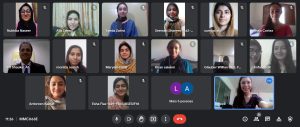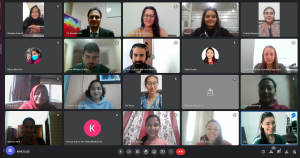In the vast tapestry of this planet, the interwoven threads of weather and climate form a mesmerising connection that shapes our very existence. A groundbreaking course swept across the borders like a gust of fresh air, unveiling the atmospheric wonders and the enigmatic bond between people.
To empower the female researchers of South Asia (Bangladesh, Nepal, and Pakistan), an online course titled “Introduction to Atmospheric Science: A Look into the Southern and Northern Hemispheres” was organised under the project of Asia Pacific Network (APN) Global Change Research project CRRP2018-04MY-Ali, “Towards Robust Projections of Climate Extremes and Adaptation Plans over South Asia” (https://doi.org/10.30852/p.4583) that Dr Shaukat Ali led from the Global Climate-Change Impact Studies Centre (GCISC), Pakistan.
Dr Stevenson of APN highlighted that “the project initiative met the urgent demand for high-resolution regional climate data. It provided crucial data, organized gender-inclusive workshops training over 200 students and young researchers, published eight research papers, and fostered substantial collaborations, showcasing APN’s key role in promoting research, capacity development, science-policy engagement, and collaboration in the region.”
Professor Michelle Simões Reboita, from Brazil, visited Nepal and Pakistan to train researchers and students in climate modelling and data analysis. During these workshops, she identified a gender gap in atmospheric science in both countries. She initiated an international course to promote female participation to address this gap and set a new research standard.
The 60-hour online course, held from March to July 2023, was supported by technical and teaching expertise from Universidade Federal de Itajubá (UNIFEI). It covered many atmospheric science topics, starting with physics fundamentals, including energy, radiation, thermodynamics, and atmospheric motion.


Tapping further into the course, it started with delving into the fundamentals of physics, including energy, radiation, thermodynamics, and atmospheric motion. The direction of the course was further turned towards the atmospheric makeup of Earth’s fundamentals of meteorology, which are the basics of atmospheric science. Over time, the course ventured deeper into complex topics like hydrological cycles, humidity and atmospheric moisture, atmospheric stability, cloud formation and stability, air pressure, air masses and air fronts, wind patterns, weather reports, map analysis, general circulation of the atmosphere, cyclones and anticyclones, tropical storms, meteorological hazards, and climate system. Notably, the curriculum was strategically designed to encompass the phenomenon of significant relevance to the South Asian region, including the intricate monsoon phenomenon, synoptic and mesoscale systems, and the compelling urgency of addressing climate change.
The learning methodology transcended conventional techniques, providing students access to the MOODLE portal on the UNIFEI platform. This portal was a hub for weekly assignments and study resources, including lectures, short videos, infographics, and research articles. The students got access to a digital library that further enhanced the depth of the learning experience. Throughout the course, students received excellent technical assistance, enabling them to acquire skills in navigating meteorological websites, using digital libraries, and effective communication.
This course was a resounding success, providing a robust foundation for the female participants. The students found this course remarkable and were left highly satisfied, as evident in their own words. A representative from Bangladesh, Ms Mariam Begum, shared the transformative impact of the course on her career:
“Being a physics student, I wanted to build my career in the field. However, this course motivated me to be a meteorologist and work in environment-related areas.”
She emphasised the fact that before this course, she was utterly unknown to the environment and its intricate phenomenon and continues to say:
“The course helped me define my goals as it offered an excellent platform for climate research providing a rewarding learning experience, ultimately leading to my current role as a researcher at the National Oceanographic and Maritime Institute.”
Further on, a female researcher, Ms Muna Bhurtel, representing Nepal, shared that:
“This course has significantly empowered me and other women by fostering our understanding of crucial environmental factors and greatly contributing to our capacity-building, thus enabling us to excel in related fields and contribute meaningfully to global challenges”.
On behalf of Pakistani female researchers, Ms Khadija Ashraf expressed her gratitude for the opportunity:
“Personally, this course has kindled my curiosity about meteorology and its impact on our daily lives. As a Pakistani woman, I believe such knowledge is instrumental in empowering women by giving them insights into scientific fields. It encourages us to break barriers and be active contributors as women in understanding weather, climate change, and their impacts; we can confidently engage in discussions and initiatives that shape our planet’s future”.
She further emphasised that:
“This course fostered meaningful connections with peers and experts of different regions of South Asia, thus resulting in invaluable networking and collaboration opportunities”.
The course’s significant emphasis on capacity-building among female researchers has broken down barriers and promoted inclusivity in traditionally male-dominated fields. As a result of this course, many female participants have embarked on their research journeys. Some female students secured admission to top universities due to this groundbreaking course. Since this course rewarded participants with e-certificates from an international university, it has been a stepping stone for aspiring researchers, contributing significantly to their research careers.
The course’s online format and international collaboration fostered global networking among peers and experts, providing an excellent cross-cultural learning and cooperation platform. As students from different countries and cultural backgrounds interacted and exchanged ideas, it enhanced global perspective and cultural sensitivity and improved communication. This inter-ethnic learning facilitated a seamless collaboration among the female researchers on climate research projects and initiatives. Sharing ideas, knowledge, and expertise yielded a better understanding of the atmospheric phenomenon across different parts of the planet, especially South Asia. Similarly, this interaction cultivated a sense of shared responsibility among the participants, creating a powerful force for positive change. Connections like these can pave the way for joint efforts to mitigate climate change impacts, share best practices, and collectively seek solutions to climate-related challenges.
Through the active engagement of female students in policy outreach initiatives, we are catalysing the development of a new wave of female leaders in climate change research and communication. This proactive involvement will play a pivotal role in influencing policies that hold the potential to bring positive transformations in both educational and professional spheres. Not only will this further contribute to advancing students’ academic journeys and career trajectories, but it will also shape the trajectory of our society as we march towards a more sustainable and equitable future. Empowering women in such fields also strengthens our response to climate change. Hence, investment in such initiatives unlocks diverse talents that enhance the global, regional, and local capacities to tackle, adapt, and mitigate environmental challenges.
The article represents a collaborative endeavour involving K. M. Kainat Bangash from Pakistan and Rajani Neupane from Nepal, who were participants in the course, epitomising the shared ethos of education and collaboration.
Dr Stevenson highlighted that “the enriched global perspectives have contributed to a more sustainable and equitable future and further commended the authors and participants for their outstanding work, which is a beacon of hope in our collective journey towards a better world”.
This course was an unprecedented display of global collaboration among female researchers that forged a dynamic alliance that transcended borders and the atmosphere. The journey of this atmospheric connection is summed up in this phrase:
Women and research, a story unfolds
Building women’s capacity, for challenges untold
With networking and collaboration, success is tenfold
M. Kainat Bangash
